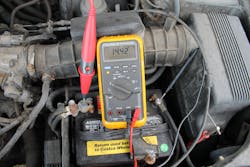Tool Q&A Question 3: Verify the voltage the alternator is producing
Alternators serve two distinct purposes on any vehicle, the first is to provide power to meet all of the electrical needs while the engine is running (electrical system, lights, interior accessories, etc). The second is to charge the battery, so it will have enough power to prime the fuel pump, crank the engine and start the vehicle.
There are many things that go wrong with the electrical systems on a vehicle, and typically it will boil down to something other than a major component. Corrosion, grounding issues, and open circuits are the three main culprits when you are trying to find a problem. So, rather than “throwing parts at it,” first you will need to try and pinpoint what is actually wrong.
Q: I verified the belt is correctly tensioned, and there are no loose connections or corrosion. Is it time to swap out the alternator?
(Tool Q&A Question 2: Improper tension of the drive belt may cause alternator charging issues)
A: Not yet. Next you will want to verify the voltage that the alternator is producing when the engine is running with and without additional power draws. First, using your multimeter to take a reading of the battery voltage with the vehicle off. It should read between 12.4V and 12.6V. If the volts are too low, charge the battery. If the volts are too high, turn the headlights on for a minute, turn them off and re-read the voltage. Continue doing this until the volts read between 12.4V and 12.6V.
Next, you will need to start the vehicle and with no additional accessories running (lights, radio, fan, etc), take a reading at the battery terminals. You will need to see a reading at minimum 0.5V higher than the battery voltage when the vehicle is off.
With the vehicle still running, turn on all the accessories you can (high beams, radio, a/c or heat, defroster, etc). Take another reading at the battery terminals. You should see at minimum 0.5V higher than the battery voltage when the vehicle is off.
